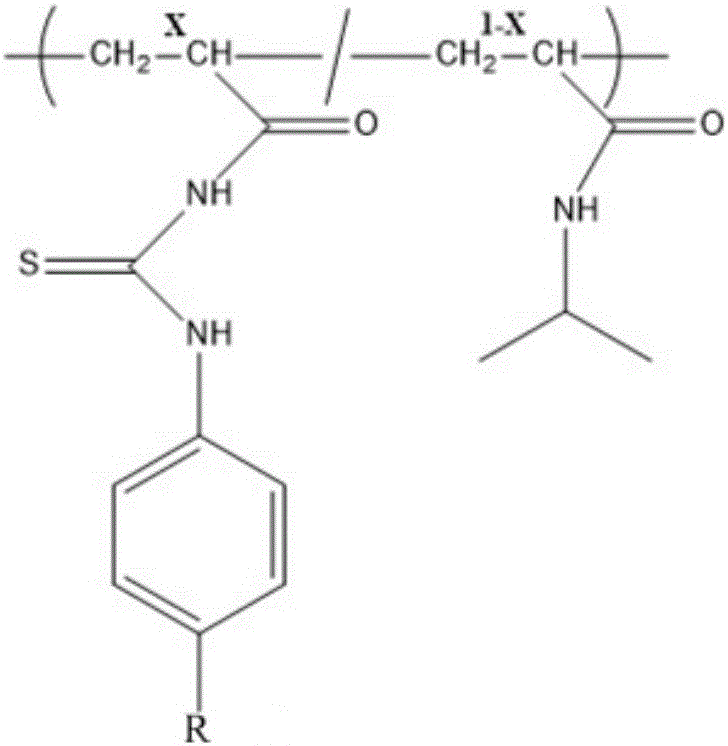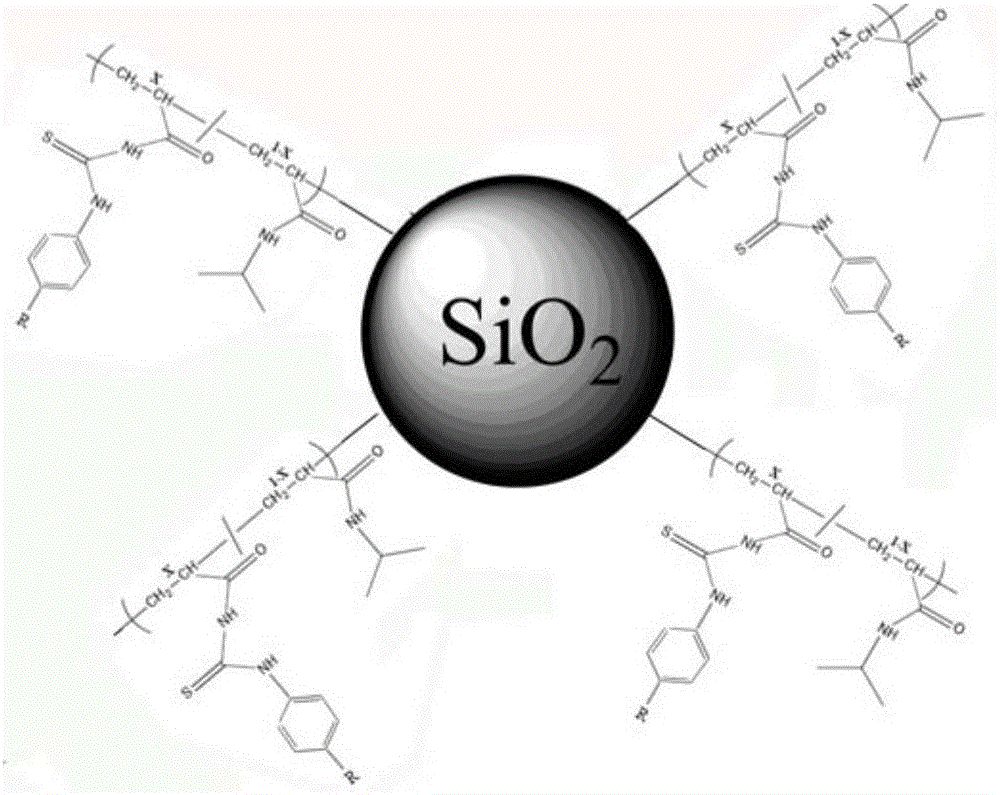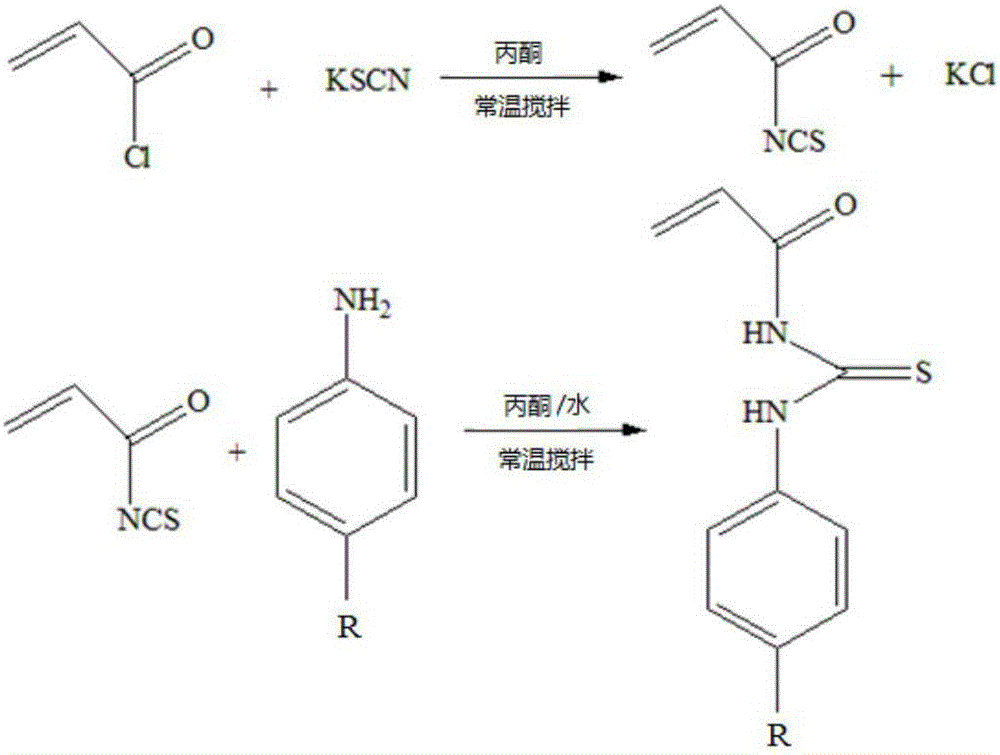Method for enriching and detecting phosphorylated proteins
A phosphorylated protein, non-phosphorylated technology, applied in the fields of material analytical chemistry and organic chemistry, can solve the problems of difficult separation of phosphorylated proteins, gaps in phosphorylation information, etc., and achieve high separation efficiency, small sample loss, and high selectivity. Effect
- Summary
- Abstract
- Description
- Claims
- Application Information
AI Technical Summary
Problems solved by technology
Method used
Image
Examples
Embodiment 1
[0047] Preparation of enriched material
[0048] Two-component copolymer structures such as figure 1shown, where X=0.01-0.5. Taking X=0.2 as an example, in a 25ml three-necked flask, add 0.4mmol of isopropylacrylamide and 0.1mmol of thiourea functional monomer successively, the substance molar ratio is 4:1, and at the same time add 6mL of ultrapure water and 6mL of DMF as solvent Introduce nitrogen under stirring, after the monomer is fully dissolved, add catalyst CuBr 0.032g and bipyridine ligand 0.16mL under nitrogen protection, then the reaction system is evacuated and filled with nitrogen to remove residual oxygen in the reaction system; Immerse the brominated substrate into the prepared reaction solution; control the temperature of the flask at 70-90 ° C and let it stand for 12-36 hours; after the reaction, use N,N'-dimethylformamide (DMF) and Deionized water (H 2 O) Wash the polymer graft surface in turn to obtain an enriched material. The thickness of the two-compone...
Embodiment 2
[0051] Structure and Synthesis of Functional Monomers
[0052] In order to prepare the above-mentioned polymer, it is necessary to synthesize a series of thiourea functional monomers, and the synthetic methods of their specific implementation are similar, and the synthetic steps are as follows. image 3 shown.
[0053] Taking the synthesis of a thiourea monomer whose terminal group R is a carboxyl group as an example, at room temperature, dissolve 0.582g (6mmol) in 30-50mL of anhydrous acetone, and under stirring, add 0.453g (5mmol) of acryloyl chloride dropwise It was added dropwise to the above solution, and the reaction was continued for 12 hours. After the reaction, centrifuge (4500r / min, 5min), and take the supernatant for use. At room temperature, 0.685g (6mmol) of p-aminobenzoic acid was dissolved in 30mL of anhydrous acetone, 2 to 4mL of ultrapure water was added, and the standby clear liquid was added dropwise to the above solution under stirring conditions, and the...
Embodiment 3
[0060] The adsorption behavior of α-casein and bovine serum albumin on the surface of the enriched two-component copolymer was evaluated by the method of QCM-D adsorption capacity determination, taking the thiourea monomer whose R-terminal group is a carboxyl group as an example. The polymer was grafted to the surface of the QCM-D chip as described in Example 1, and α-casein and bovine serum albumin were adsorbed with 10% acetonitrile + 90% deionized water as the carrier liquid under the temperature control of 20 °C. experiment. Figure 4 The different adsorption behaviors of α-casein and bovine serum albumin on the surface of the two-component copolymer were shown, which fully demonstrated the ability of this two-component copolymer to specifically adsorb phosphorylated proteins.
PUM
| Property | Measurement | Unit |
|---|---|---|
| Thickness | aaaaa | aaaaa |
| Diameter | aaaaa | aaaaa |
| Aperture | aaaaa | aaaaa |
Abstract
Description
Claims
Application Information
 Login to View More
Login to View More - R&D
- Intellectual Property
- Life Sciences
- Materials
- Tech Scout
- Unparalleled Data Quality
- Higher Quality Content
- 60% Fewer Hallucinations
Browse by: Latest US Patents, China's latest patents, Technical Efficacy Thesaurus, Application Domain, Technology Topic, Popular Technical Reports.
© 2025 PatSnap. All rights reserved.Legal|Privacy policy|Modern Slavery Act Transparency Statement|Sitemap|About US| Contact US: help@patsnap.com



